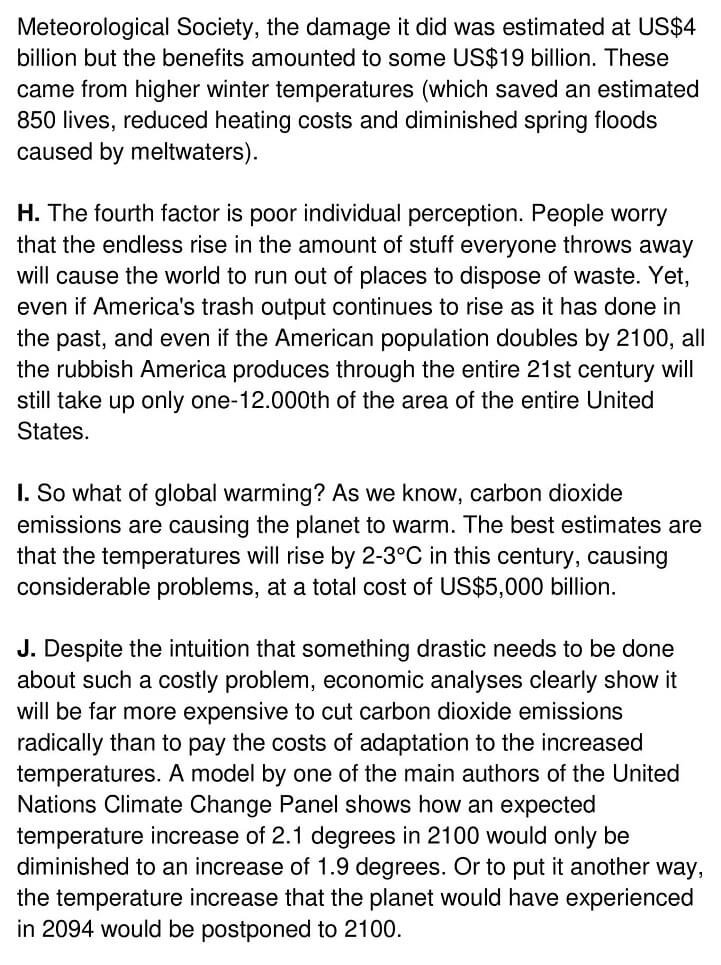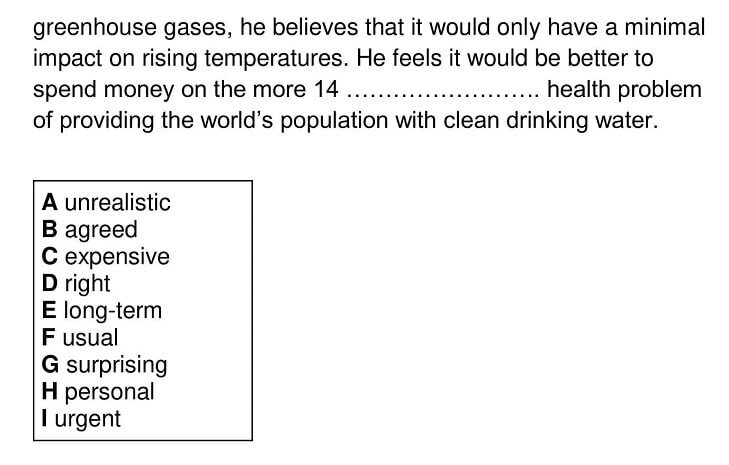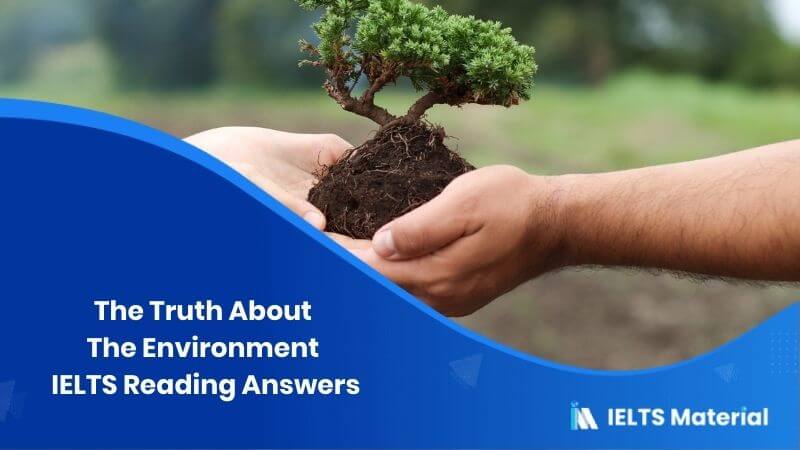The Truth About The Environment – IELTS Reading Answers
6 min read
Updated On
-
Copy link
Table of Contents

Limited-Time Offer : Access a FREE 10-Day IELTS Study Plan!
The Reading Module of the IELTS can be the top-scoring category, with diligent practice. To achieve the best results in this section, you must understand how to approach and answer the different Question types in the Reading Module. By solving and reviewing Sample Reading Questions from past IELTS papers, you can ensure that your Reading skills are up to the mark.
The Academic passage ‘The Truth About The Environment’ is a reading passage that appeared in an IELTS Test. Try to find the answers to get an idea of the difficulty level of the passages in the actual reading test. If you want more passages to solve, try taking one of our IELTS reading practice tests.
The Truth About The Environment







Answers
Unlock Answers
| Question number | Answer | Explanation | |
|---|---|---|---|
| 1 | YES | The first sentence of paragraph A mentions that for many environmentalists, the world seems to be getting worse (pessimistic/negative view of the world). They have developed a hit-list of our main fears(a number of reasons). As the statement agrees with the claims of the writer, the answer is YES. | |
| 2 | NOT GIVEN | In paragraph 2, it is given that energy and other natural resources have become more abundant since the book The Limits to Growth was published in 1972 by a group of scientists. This is the only mention of 1972 in the whole passage and it tells us that the use of natural resources increased. There is no information on data on the Earth’s natural resources being collected since 1972. Hence, the answer is NOT GIVEN. | |
| 3 | NO | Paragraph B points out that more food is now produced per head of the world’s population than at any time in history and so fewer people are starving. As the statement contradicts the claims of the author, the answer is NO. |
|
| 4 | NOT GIVEN | In paragraph A, the writer communicates that species are becoming extinct in vast numbers. Later in the next paragraph, it is added that although species are indeed becoming extinct, only about 0.7% of them are expected to disappear in the next 50 years, not 25-50%, as has so often been predicted. Besides these two mentions of species becoming extinct, there is no other note on whether new species are replacing the extinct species or not. So, the answer is NOT GIVEN. |
| 5 | YES | Paragraph B states that most forms of environmental pollution (some pollution problems) are mostly associated (correctly linked) with the early phases of industrialisation and therefore best cured not by restricting economic growth, but by accelerating it. As the statement agrees with the claims of the writer, the answer is YES. |
| 6 | NO | Paragraph B relates that most forms of environmental pollution are associated with the early phases of industrialisation and therefore best cured not by restricting economic growth, but by accelerating it. So, the author is claiming that it is best to develop industries and let economic growth increase. As the statement (It would be best to attempt to slow down economic growth) contradicts the claims of the author, the answer is NO. |
| 7 | C | Paragraph D brings out the fact that the first factor of disjunction between perception and reality is the lopsidedness built into scientific research. Scientific funding goes mainly to areas with many problems (selected areas that the researchers think have more problems). That may be wise policy, but it will also create an impression that many more potential problems exist than is the case. So, selection of areas to research may create bias. Hence, the answer is C (the selection of areas to research). |
| 8 | D | Paragraph E reveals that environmental groups need to be noticed by the mass media as they need to keep the money rolling in. As a result, they sometimes overstate their arguments (exaggerate their claims). To prove this, the author quotes a press release entitled: ‘Two thirds of the world’s forests lost forever’ that the World Wide Fund for Nature issued In 1997. The truth turns out to be nearer 20%. Hence, the answer is D (environmental groups can exaggerate their claims). |
| 9 | C | Paragraph F expresses that the lobby groups share many of the characteristics of other lobby groups. But this feature would matter less if people applied the same degree of scepticism to environmental lobbying as they do to lobby groups In other fields. This means that some of these groups receive criticism whereas, some receive accolades even if they deal with the same issues. For example, a trade organisation arguing for weaker pollution controls is instantly seen as self-interested (criticism), but a green organisation opposing such a weakening is seen as altruistic (praise), even if an impartial view of the controls in question might suggest they are doing more harm than good. Hence, the answer is C (Some receive more criticism than others). |
| 10 | B | Paragraph G discusses that newspapers and broadcasters are there to provide what the public wants. So, newspapers print items that are intended to meet the expectation of the readers. Hence, the answer is B (meet their readers’ expectations). |
| 11 | B | Paragraph G explains that as newspapers and broadcasters provide what the public wants, it can lead to significant distortions of perception. An example was America’s encounter with El Nino in 1997 and 1998. This climatic phenomenon was accused of wrecking tourism, causing allergies, melting the ski-slopes and causing 22 deaths. However, according to an article in the Bulletin of the American Meteorological Society, the damage it did was estimated at US$4 billion but the benefits amounted to US$19 billion. This means that the profit is not highlighted like the damages and lead people to believe it was more important or destructive than it actually was. Hence, the answer is B (It is not as important as we have been led to believe). |
| 12 | E | Paragraph J refers to the fact that a model by one of the main authors of the United Nations Climate Change Panel shows how an expected temperature increase of 2.1 degrees in 2100 would only be diminished to an increase of 1.9 degrees. Or to put it another way, the temperature increase that the planet would have experienced in 2094 would be postponed to 2100, that is, it is a long term issue (as it is almost over 70 years) if we do not handle it in an efficient way. Hence, the answer is E (long-term). |
| 13 | D | Paragraph J indicates that despite the intuition that something drastic needs to be done about such a costly problem, economic analyses clearly show it will be far more expensive to cut carbon dioxide emissions radically than to pay the costs of adaptation to the increased temperatures. So, rather than taking drastic, inefficient steps, we need to find the right way to deal with global warming so that it does not have a catastrophic effect on the planet and affect us. Hence, the answer is D (right). |
| 14 | I | In paragraph K, the author writes that the cost of reducing carbon dioxide emissions for the United States alone will be higher than the cost of solving the world’s single, most pressing (urgent) health problem like providing universal access to clean drinking water and sanitation. The writer feels it would be better to spend the money on the more important/urgent health problem of providing solutions to the basic problems like sanitation and clean drinking water. Hence, the answer is I (urgent). |
Check More IELTS Reading Answers
Also check :
Practice IELTS Reading based on question types

Start Preparing for IELTS: Get Your 10-Day Study Plan Today!
Recent Articles

Nehasri Ravishenbagam

Haniya Yashfeen

Haniya Yashfeen

Haniya Yashfeen




Post your Comments